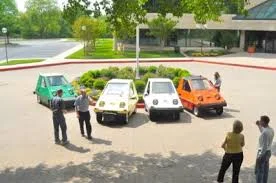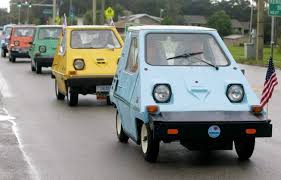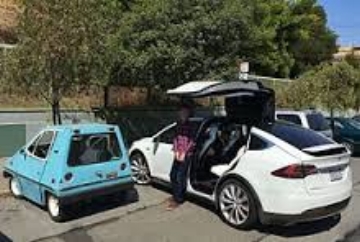The CitiCar
The CitiCar made by Sebring-Vanguard was a battery powered, 2-passenger runabout that for a short time captured the imagination of OPEC-era America. This cheese wedge-shaped shoebox on wheels plugged into the nation’s power grid from 1974 to 1982. It is hard to say if it represented a bold vision of a utopian future, or a half-baked pipe dream based on yesterday’s technology. Either way, the CitiCar is an important but often forgotten stepping stone on the evolutionary path of the electric car.
Electrics: There at the Beginning
Immersed in today’s media-hyped celebrity culture, one could be forgiven for thinking that Tesla’s founder Elon Musk invented the electric car. Not many are aware, and far fewer remember, that at the turn of the last century, the preferred power source for this brand new technology called the automobile had not yet been decided. Steam, gasoline and electricity were battling for the hearts and minds of early adaptors.
Back then, electricity actually had the edge. Early gas engines were dirty and tedious to maintain. They employed crank starters that were physically challenging and dangerous to use. Steam engines required significant technical skill to get them fired up and rolling - not to mention it was a bit disconcerting to know that you were sitting atop a pressurized boiler. Electrics were a snap to start, easy to operate, required little maintenance, and were quiet. Indeed, in the year 1900, electrics outsold both rivals by a small margin.
Electricity did have its limitations. Even the best, most pricy cars could do no better than 50 miles on a charge. Speed, hills, cold and battery age, each ate into range to the extent that range anxiety kicked in much sooner. This meant EVs were limited to short trips around town. But then again, roads back then were terrible, limiting nearly all car ownership to urban areas.
With the battle for propulsion far from settled, some of the more well-funded carmakers hedged their bets. Ransom E. Olds was evaluating both gasoline and electric cars when a workshop fire in 1901 consumed all but one of his prototypes. The only car to survive was gas powered, and so it would become the first Oldsmobile – and for the next few years the best-selling car in the world. Studebaker, after powering its vehicles by horse for its first 50 years, also spread out its bets when it first began building cars in 1902. The largest of its early investment went to EVs.
Over the next 10 years the choice in power winnowed down to two. A few steamed stalwarts like the Stanley puffed along for yet another decade, but the process proved to be too complicated and cumbersome for a typical driver to master.
a 1910 Stanley Letting off some Steam (www.StanleySteamers.com)
A few years after that, the spark began to fizzle for electrics as well. Charles Kettering, General Motor’s brilliant chief engineer, introduced the first workable electric starter on the 1912 Cadillac. Eliminating the need of the difficult and dangerous hand crank made the self-starter the most important automotive technology since self-propulsion itself. Over the next few years, as Kettering’s starter became widespread, the internal combustion engine began its assent as the dominant power source across the industry. Many early EV leaders like Baker Electric and Columbia fell by the wayside.
But electric power wasn’t completely dead yet. Internal combustion had solved the crank start problem, but gas engines were still noisy, smelly and dirty. Marketed toward women and doctors as a cleaner more reliable alternative, sales of EVs like Milburn and Detroit Electric held up for another decade. But by the 1920s, gasoline powered cars had gotten simple and reliable enough, and fueling infrastructure had expanded to the point where electric cars with their limited speed and range were all but obsolete. Detroit Electric would be the last major holdout, before going bankrupt in 1930 (although doing EV conversions and special orders until 1939) It would end up being the bestselling EV of the 20th Century.
An Occasional Buzz
Over the ensuing decades, it looked as if the electric car would follow the path of its steam-powered counterpart into the nether lands of automotive consciousness. It wouldn’t be until 1959 that a serious effort was made at an electric car come back. It was then that Emerson Radio and the Henney Body Company teamed up to build the Henney Kilowatt. Well, maybe it wasn’tall that serious. The Kilowatt was based on the Renault Dauphine, used a 36V motor and could travel 40 miles on a charge. At about half the size of a typical American car while costing twice as much, it is not surprising that only 50 or so Kilowatts were sold. Most of those were to utility companies for research or promotional duties. Henney Motors was out of business by 1961.
Henney Kilowatt (www.Electricandhybridcars.com)
A few years later, the maker of big power generators, Westinghouse Electric, produced a little box-shaped sedan called the Markette. As its name and its 35-mile range implied, the Markette was made for quick jaunts to the market. An unknown but very small number of Markettes ever made it to the market.
Westinghouse Markette (www.IMCDB.com)
During the 1960s and 1970s, the self-proclaimed “King of the Electrics” was the Electra-King, made by B&Z Industries of Long Beach, California. During the first half of the ‘King’s 17-year reign it was essentially a 3-wheeled golf cart with an enclosed body. Six-6V batteries powered a 1hp army surplus tank turret motor that could propel the 500lb cart to 18mph. That was probably plenty fast, as the E-K had no front brakes. After an ownership change in 1972, the Electra-King could be had with a bit more power and with 4 wheels…but not 4 brakes. An ideal product placement for the Electra-King would have been the 1999 James Bond flick, The World is not Enough, driven (slowly) by the beautiful and exotic supervillain, Elektra King, played by French actress Sophie Marceau. But that movie came out 19 years after B&Z had gone bankrupt.
The Electra-King was the King of the Electrics.
Elektra King was the queen of Bond Vlillans
The Sebring-Vanguard CitiCar
The 1970s was an decade that many car enthusiasts prefer to forget. Sensuous styling, mixed with pavement melting horsepower, had made the previous age a golden one for the American automobile. Suddenly it had vanished, swept away by a quadruple blast of inflation, recession, fuel shortages and regulation. As automakers struggled to adapt their old ways of thinking to a new reality they were ill prepared to face, pessimism ran rampant. Innovation took a back seat to survival. The future of the car as we knew it was in question.
www.SeekingAlpha.com
Out of the depths of this malaise, Bob Beaumont, a charismatic Chrysler dealer from Upstate New York, decided that the time was ripe to upend the American automobile industry. He sold his dealership and began working with small EV firms that converted gasoline cars into electrics. By 1973, Beaumont had founded Sebring-Vanguard Corporation, and was producing a tiny electric coupe that was not much more than a 4-wheeled scooter with a roof and a steering wheel.
From the Vanguard Coupe (top left) to Sebring-Vanguard CitiCar Sports Coupe (bottom right) www.RcI.Rutgers.edu
Beaumont’s next EV was the 1974 CitiCar SV36. The SV36 was designed to be the cheapest, most basic vehicle one could make, and still meet NTSB standards to be called a car. Car? The SV36 was more like the missing link on the evolutionary progression from golf cart to automobile. Priced at just $2,700, it was powered by a 3.5hp motor and six 6-volt batteries. CitiCar claimed a 28mph top speed and 35-mile range. These numbers decreased rapidly if hills and/or cold weather were involved.
The following year, Beaumont introduced the CitiCar SV48. By adding two extra batteries, the car’s range and top speed were extended somewhat - though that was probably an either/or proposition. By 1976, CitiCars had actually become moderately appealing. Called the Hatchback Coupe, it now had real doors instead of plastic curtains, a hatch accessing the rear storage shelf, and a new 6.5hp motor. A slightly longer version called the CitiVan was offered in 1977, but it was too late for Sebring-Vanguard. Despite these improvements, motor and battery technology was really not much more advanced than the EVs from 75 years earlier.
www.Oddimotive.com
Bob Beaumont managed to sell about 2400 EVs over 4+ years before becoming over-extended. The company went bankrupt in 1978.
After the CitiCar
Sebring-Vanguard’s assets were soon purchased by a New Jersey company with plans to resume EV production. Because there was a cloud hanging over some of Bob Beaumont’s business dealings, the new owners changed the company name to Commuter Vehicles, Inc. The CitiCar was renamed the ComutaCar. Two thousand more ComutaCars were made into the 1980s. Some of the last several hundred vehicles were sold to the U.S. Postal Service. That relationship ended badly. Commuter Vehicles folded in 1982.
Commuter Vehicles may have sold the U.S Postal Service more than its ComutaVan could deliver (www.CLassic-Car-History.com)
Bob Beaumont was back in the EV business in the early 1990s. This time his offering was a bit less austere. The estimated 20-25 Tropica electric sports cars he built in 1994 were Beaumont’s last EVs.
1994 Tropica .(www.CLassic-Car-History.com)
With over 4400 cars sold from 1974-1982, the CitiCar in its various names and forms would edge out Milburn Electric (just over 4000 cars from 1914-23) and end up trailing only Detroit Electric (about 12,500 cars from 1907-1939) as the 20thCentury’s most popular electric car.
Bob Beaumont passed away in the autumn of 2011. That was only a few months before Tesla introduced its mass-produced Model S…and America’s perception of the electric vehicle was forever changed.
www.wikipedia.com
Copyright@2019 by Mal Pearson
















